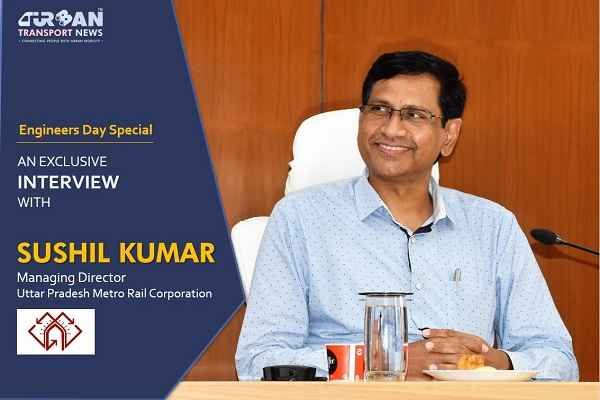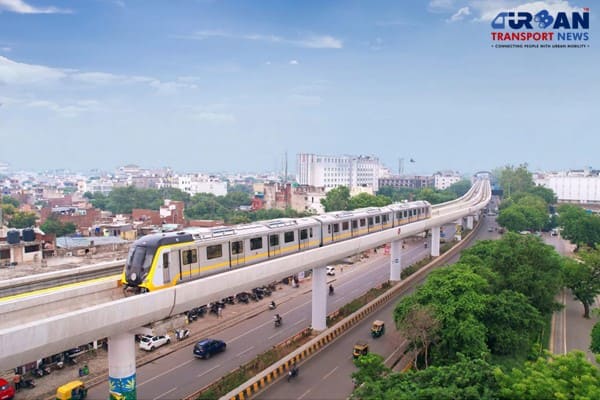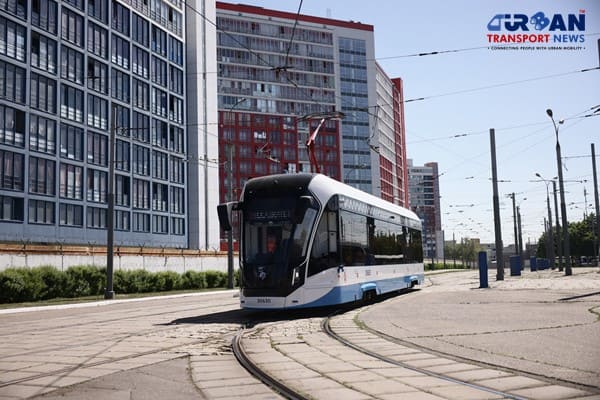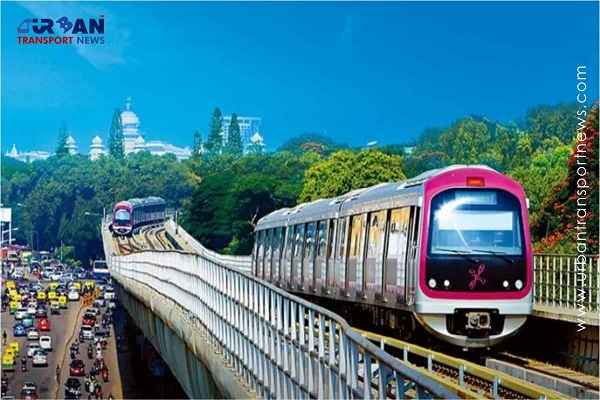 Qatar approves Saudi Rail Link Agreement, Accelerating Gulf Railway Vision 2030
Qatar approves Saudi Rail Link Agreement, Accelerating Gulf Railway Vision 2030 UP Govt plans to introduce Water Metro services in Ayodhya, Varanasi & Prayagraj
UP Govt plans to introduce Water Metro services in Ayodhya, Varanasi & Prayagraj India’s First Urban Ropeway begins Trial Run in Varanasi, Set to carry 1 Lakh passengers daily
India’s First Urban Ropeway begins Trial Run in Varanasi, Set to carry 1 Lakh passengers daily India and Bhutan to Build First-Ever Rail Link: ₹4,033 Cr Project to Boost Regional Connectivity
India and Bhutan to Build First-Ever Rail Link: ₹4,033 Cr Project to Boost Regional Connectivity Patna to launch Eco-Friendly Water Metro; Trial Run soon between Digha and Kangan Ghats
Patna to launch Eco-Friendly Water Metro; Trial Run soon between Digha and Kangan Ghats Air India Group set to launch Flights Operations from Navi Mumbai International Airport
Air India Group set to launch Flights Operations from Navi Mumbai International Airport Chennai to launch 25-Year Mobility Plan with Unified QR Ticketing and One-App Transit System
Chennai to launch 25-Year Mobility Plan with Unified QR Ticketing and One-App Transit System Kochi Metro bags ₹4.4 crore contract to prepare DPR for Mumbai Water Metro Proejct
Kochi Metro bags ₹4.4 crore contract to prepare DPR for Mumbai Water Metro Proejct Navi Mumbai International Airport set for September launch; IndiGo and Akasa Air to lead Operations
Navi Mumbai International Airport set for September launch; IndiGo and Akasa Air to lead Operations Noida International Airport to be Inaugurated on October 30, Commercial Flights in 45 Days
Noida International Airport to be Inaugurated on October 30, Commercial Flights in 45 Days
Exclusive Interview with Sushil Kumar, Managing Director, Uttar Pradesh Metro Rail Corporation

Sushil Kumar is a senior technocrat and the acting Managing Director of Uttar Pradesh Metro Rail Corporation Ltd (UPMRC). He joined UPMRC in 2015 and has contributed significantly to the metro rail operations in Lucknow and now in Kanpur as well.
Sushil Kumar has about 28 years of experience working in senior positions in Indian Railways, Delhi Metro Rail Corporation (DMRC) and UPMRC. Under his visionary leadership, the UPMRC is presently implementing the metro rail systems in Agra and Kanpur cities.
In a recent interaction with Urban Transport News, he frankly talked about his priorities and strategies to provide sustainable & smart public transportation systems for the people.
First, kindly accept our heartiest congratulations on taking charge as the acting managing director of India's one prestigious and role modal metro authority Uttar Pradesh Metro Rail Corporation (UPMRC). You have been associated with the rail & Metro industry for more than 35 years, kindly share some information about your academic & professional journey.
Thank you for the good wishes. I would like to tell the readers that I am a graduate of IIT Roorkee & a postgraduate from IIT Delhi. Previously, I served in the Ministry of Railways as Director/Power and was a member of different committees in the fields of Energy Conservations, and Energy Planning under different Ministries. Before that, I served as Additional General Manager for Delhi Metro Rail Corporation and helped in the set up of state-of-the-art maintenance facilities for the maintenance and overhauling of trains. I hold expertise in project management, design specification, technical support, operations, and maintenance in Indian Railways and urban transit & metros for Rolling Stock/Trains, Signalling, Traction Power systems, and Telecommunication including operation.
I have also worked as Chief Electrical Inspector General to the Government of India besides working as National Project Director for the UNDP project for Energy Conservation.
Before taking the responsibilities of Managing Director in UPMRC, I served as Director (Operations) and was responsible for day-to-day Operation & Maintenance activities.
I have also received the “National Award for Outstanding Service” from the Ministry of Railways and the Outstanding Performance Award for my services in DMRC.
What is the current progress of the remaining sections of Kanpur Metro? Is there any new innovation or technology being adopted to complete the project ahead of schedule?
The commercial run on the 9KMs long Priority Section (IIT-Kanpur to Motijheel) of the Kanpur Metro Rail Project commenced on 29th December 2021 which was inaugurated by Hon’ble PM Shri Narendra Modi in the esteemed presence of Hon’ble Chief Minister, Uttar Pradesh Yogi Adityanath on 28th December 2021. The Priority Section of Kanpur Metro has been completed and commissioned within a record time of 2 years & 1.5 months. This Priority Section is a part of Corridor-I (IIT-Naubasta), which is approx 23KMs long. Beyond the priority stretch, the construction is been executed on the whole remaining section of the corridor in phases for better efficiency and execution.
A 4KMs long underground stretch is being constructed between Chunniganj and Nayaganj having 4 underground Metro Stations viz. Chunniganj, Naveen Market, Bada Chauraha and Nayaganj. It is to be mentioned that this stretch is passing through the most important market and shopping places of the city.
Two state-of-the-art Tunnel Boring Machines ‘Nana’ and ‘Tatya’ have been launched for the tunnel construction under this section. UPMRC has named these machines after the names of famous revolutionaries of the city; Nana Rao Peshwa and Tatya Tope.
Beyond this stretch, the remaining 3KMs long UG section of the corridor - 1 passing through the busiest and most important places of the city including Kanpur Central Railway, Jhakarkatti, and Transport Nagar is being constructed. Soon, the TBMs for this section will be launched from the Nayaganj. And with this, there will be 4 TBMs working at the same time in the city.
Construction works on the elevated balance section including 5 elevated stations stretching from Bara Devi to Naubasta have also been started.
This parallel working strategy has been adopted to complete the corridor within the challenging deadline and UPMRC is leaving no stone unturned to repeat the history by completing the Kanpur Metro’s corridors on time. UPMRC is also planning to float the tenders for the construction of 8.6KMs long Corridor-II stretching between Chandra Shekhar Azad Agriculture University and Barra-8 with Rawatpur as the interchange point.
For this remarkable fast pace of construction and world-class infrastructure and aesthetic, many innovations laid the foundation that had been executed during the construction phase of Kanpur Metro Project’s Priority Section and among which ‘Double T-Girder’ was a very noticeable one. This happens to be the first time in India that a Double T-girder was used for the construction of Metro Station’s concourse level base. Not only this is an improved technique for the construction of the base of the concourse level as compared to the traditional shuttering method, but it also makes the concourse area look better in terms of aesthetics and design and above all saves time. This innovation leads to the completion of construction of the base of the concourse levels of all the 9 Metro Stations of the Priority section in just 7.5 months.
What is the current progress of the Agra Metro Rail project and when is the priority corridor of the project scheduled to be ready for the use of the public?
Agra Metro Rail Project, inaugurated by the Hon’ble Prime Minister of India on 7th December 2020 in Presence of Chief Minister of Uttar Pradesh Yogi Adityanath is being executed at a very fast pace by the team of UP Metro. In a short span of around one year and 8 months, the entire piling work, pile cap work, erection of piers for the priority corridor, and erection of all 144 Double T-Girders for elevated stations in the priority corridor have been successfully completed. The erection of U-Girders is also going to be completed very soon. Simultaneously, the construction work for underground stations is also being carried out at a fast pace.
The finishing works of elevated metro stations of priority corridors have also reached an advanced stage, with systems and utilities work in place. The track work for the priority corridor commenced on 08th July 2022, in a record time.
Similarly, plunge column work also began at Agra Fort Metro Station and the set up of the RSS (Receiving Sub-Station) started at ISBT Metro Station.
A world-class metro depot is being constructed for the first corridor of the Agra Metro Project, and the test track for a trial run of the metro trains is also ready in the depot. Similarly, the OCC building (Operations Control Center) is also coming into shape which will be equipped with highly advanced technology. The signalling works have also begun and shunt signals are being installed inside the Agra Metro Depot Premises. The entire metro operations on the first corridor of the Agra metro will be controlled from the depot.
The Agra metro team is working diligently to deliver a world-class metro to the people of Agra in time. We hope to start the revenue operations on the priority corridor of Agra Metro by the beginning of the year 2024.
UPMRC is executing underground metro sections for the first time in the state. Did you find any major engineering challenges in the execution of underground corridors/stretches of Kanpur and Agra Metro? How are you dealing with these challenges to keep the construction activities smoothly?
As mentioned above also, in Agra, presently the underground section work is going on for 7 stations for the first corridor of the Agra Metro Project. The D wall work is presently underway for the underground stations of Agra Metro.
The D-wall can be understood as the boundary of a Metro Station. Before starting the construction of an Underground Metro Station, this wall is constructed as a security enclosure around it. The D-Wall will be constructed with rectangular panels. This wall will exist up to a depth of approximately 21 meters. The D-Wall gives strength to the under-construction underground station walls and paves way for Tunnel Boring Machines (TBM) to construct a tunnel for the underground section.
In all, Seven Metro Stations are to be built in the Underground Section for the first corridor of the Agra Metro Rail Project, viz Taj Mahal, Agra Fort, Jama Masjid, Medical College, Agra College, Raja Ki Mandi and RBS College.
It is to be noted that the underground stations of Agra Metro will also be prepared with the Top-Down Method i.e. construction work will be done from top to bottom. This system is being adopted to minimize the impact on traffic as the barricading on the road will be reduced after the construction of the first floor starting from the road level. The construction work of the station below the road will continue and the movement of vehicles on the road will also continue smoothly eventually.
Is there any new update on the proposed Charbagh - Vasantkunj Metro Corridor 2 of the Lucknow Metro Rail Project? Kindly also share some new updates on the proposed Light Rail Transit System in Gorakhpur and some salient features of the project.
UPMRC has revised the DPR of the East-West Corridor of Lucknow Metro Rail Project i.e. proposed between Charbagh and Vasant Kunj as per the directions of the government. The revised and updated DPR has been submitted to the Government of Uttar Pradesh (GoUP). The total route length of the corridor will be 11.165 km of which the elevated length will be 4.286 km while the underground length will be 6.879 km. The total number of stations in this corridor will be 12 comprising 7 underground and 5 elevated stations. The estimated time of completion is 5 years.
The Depot of this corridor will be constructed at Vasant Kunj. The estimated capital cost without taxes for constructing this 11.165 km long corridor in February 2019 was Rs 3786 crores which have escalated to Rs 4264.89 crores. The change in cost is in sync with the current inflation rate as per government guidelines.
DPR has been also upgraded with a 750 DC traction system which is being followed in the Kanpur & Agra Metro project mainly due to severe OHE flashing problems occurring as a result of metallic wire in kites being faced in the Lucknow Metro project.
The 15.14 km long corridor of Gorakhpur Metro Lite Rail Project (Shyam Nagar to MMM Engineering College) has also got approval from Public Investment Board (PIB) on 22nd November 2021 at an estimated completion cost of Rs 2670.37 Crore.
UPMRC recently signed a prestigious contract with DB International Operations (a subsidiary company of Deutsche Bahn AG) to train their engineers for providing operation & maintenance services to India's first RRTS project. Kindly share some insights on this new achievement.
UPMRC has started training of newly recruited staff of German Rail company DB ie. Deutsche Bahn at the training institute (CoET) of Transport Nagar Depot. In the ultra-modern training Institute of Lucknow training is being provided to a batch of 150 trainees of Train Operator (SCTO) and Maintainer staff of DB. In 90 days of training, these trainees will learn the nuances of train operation and maintenance.
German Rail Company 'DB' had earlier come to India and surveyed the training institutes of various metro and rail projects to train its newly recruited staff. DB studied the efficiency of the employees who got training from the training institute of UPMRC and also tested the world-class facilities of the training institute. After which the Centre for Excellence of Training (COET) of UP Metro was selected for its newly recruited staff. The Training Institute of UPMRC is equipped with ultra-modern facilities among the Metro Rail Training Institutes across the country. So far more than 1100 trainees have received technical training in Metro Rail Operation and Maintenance from this training institute.
The training institute of UP Metro has set up world-class standards of training today. For the successful conduct of metro operations in Lucknow and Kanpur, the training of technical staff was done in CoET itself. Today all those employees are making us proud by achieving excellence in their respective fields. It is certainly a proud moment for us that we are also providing training in the field of train operation and passenger services to the personnel of reputed foreign railway institutes like German Rail Company which is a commendable achievement in itself.
It may be noted that DB, i.e. Deutsche Bahn will deploy these trainees for the RRTS project to be operated between Delhi-Ghaziabad-Meerut.
Is UPMRC also developing any training institute/academy in line with DMRC to provide world-class training and develop new manpower for the upcoming metro rail projects in India?
UPMRC has already set up a training facility/institute at Transport Nagar Metro Depot in Lucknow which provides training to newly recruited staff & trainees before handing them charge of their work, duties and responsibilities in their respective fields. The training institute is named as Centre of Excellence for Training (CoET) which has successfully imparted both technical and professional training for 4 years now. It has world-class infrastructure and a state of the art facilities to cater to the needs and requirements of professional/technical training and has been grooming young minds in developing manpower for the upcoming Metro projects of Kanpur & Agra.
Recently, UPMRC also provided train operations training to the employees of German Rail Company, DB (Deutsche Bahn). German Rail Company 'DB' had earlier come to India and surveyed the training institutes of various metro and rail projects to train its newly recruited staff. The DB studied the efficiency of the employees who got training from the training institute of UPMRC and also tested the world-class facilities of the training institute. After which the Centre for Excellence of Training (CoET) of UP Metro was selected for its newly recruited staff. It may be noted that DB ie Deutsche Bahn will deploy these trainees for the RRTS project to be operated between Delhi-Ghaziabad-Meerut.
What is your message for young engineers and metro professionals on this Engineers Day?
First of all, I would like to share with you the significance of Engineer’s Day with you. The birth anniversary of Bharat Ratna Mokshagundam Visvesvaraya which falls on 15th September is celebrated as Engineer's Day every year. This day is celebrated in recognition of his significant contribution to the field of engineering and education. He is also considered among the greatest nation builders who have been instrumental in carrying out several architectural marvels like the Krishna Sagar dam in Karnataka & flood protection system of Hyderabad.
As an engineer and a metro professional, I urge them to take inspiration from this legendary engineer and put their heart and soul while working in the field of construction and architecture. Every individual should remain motivated and work hard with perseverance to achieve his/her target and should inspire others to innovate in the field of engineering and technology. In today’s modern era, innovation is the need of the hour and adopting new technologies to complete the project within the stipulated time frame with cost-effectiveness yields desired results. We all should work together as a team to give our best performance while acknowledging the contributions of other engineers who working tirelessly in building a modern and developed India.
Anything else, you want to share with us with respect to the contents being served by our publications - Metro Rail Today and Urban Transport Infrastructure?
The contents of the publication Metro Rail Today and Urban Transport Infrastructure are very informative and illustrative covering all the genres and aspects of Railways and the Metro Rail industry. It also comprehensively highlights the innovations and latest developments in the Mass Rapid Transit System (MRTS) sector. The journals also incorporate the latest technologies and latest forms & evolution in modes of Mass Transit at both the national level and international levels. It is a great platform to share information, views, and ideas with other technocrats thereby enhancing our reach & scope while providing new avenues & opportunities in Research & Development (R&D).







